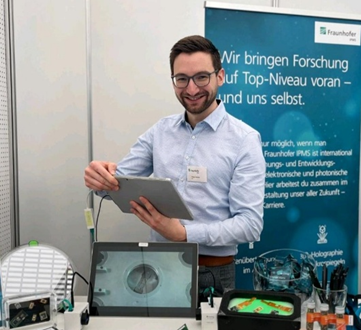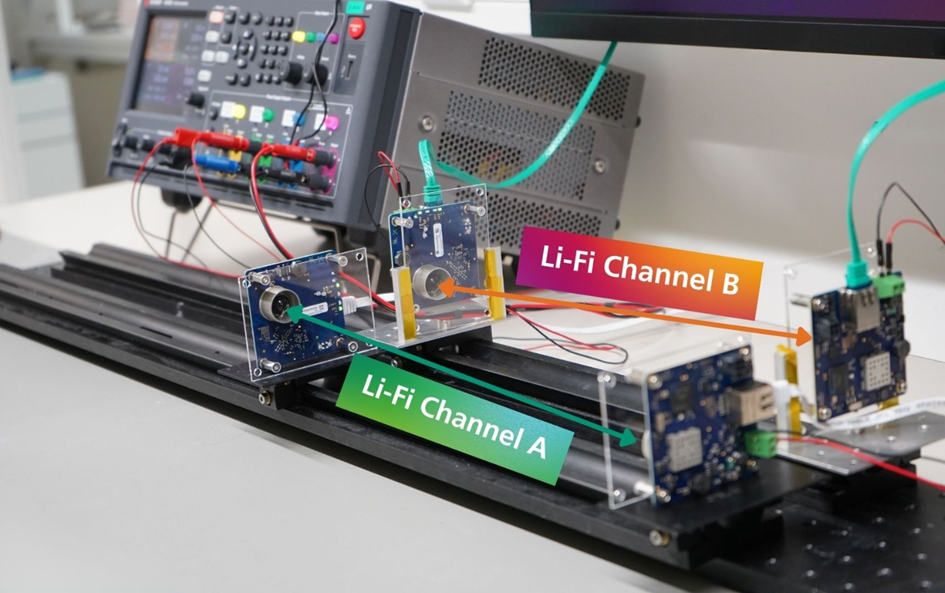We present a TSN testbed that validates wired and Li-Fi links up to 1 Gbit/s bidirectionally, with precise measurement of energy and latency. Three Li-Fi systems show deterministic latencies (Grathus ~10 µs, Arthus III ~22 µs, 1GHS ~2 ms) and a clear efficiency trend: as load increases, energy per bit decreases; 1GHS is the most efficient (down to ~3.6 nJ/bit). A simple LED bias optimization reduces 1GHS energy consumption by up to 20.2% (frontend: 27.5%) – a robust benchmark for energy-efficient, wireless real-time in industry.

A contribution from:
Dipl.-Ing. Philipp Meißner
philipp.meissner@ipms.fraunhofer.de
Business Unit Data Communication & Computing | Systems
Fraunhofer Institute for Photonic Microsystems IPMS
Energy consumption of modern networks is rising – and so is the need for reliable, real-time-capable, and mobile communication on the factory floor. Fraunhofer IPMS has developed a test environment showing how to implement real-time communication wirelessly via Li-Fi while measurably saving energy. Under realistic conditions, throughput, latency, and energy demand are captured together – yielding robust metrics that allow fair device comparisons and targeted optimization.

Simply put, real-time technology ensures that critical data arrive on time and reliably, even when the network is busy. Li-Fi transmits this data not by radio, but by light. It is fast, resilient to interference, and ideal for production halls with lots of metal or in critical areas where radio is not permitted. The testbed demonstrates a wireless link with “cable-grade” quality: very low, predictable delays and, if desired, redundancy via two separate optical links so no data loss occurs in case of a failure.
The test evaluated three industrial Li-Fi variants addressing different requirements. Grathus® is designed for long distances and delivers over 1 Gbit/s at ranges up to about 300 meters; average consumption is around 7.5 watts. The 1GHS system provides 1 Gbit/s for typical hall distances up to about 12 meters at around 5 watts and, thanks to its wide field of view, supports flexible point-to-point and small point-to-multipoint scenarios. Arthus III is a compact solution for short distances up to about 1.5 meters with 10/100 Mbit/s and particularly low power consumption of around 1.6 watts. Latency measurements show how close Li-Fi gets to wired transmission: the reference cable shows a latency of about 6 microseconds, Grathus® around 10 microseconds, and Arthus III about 22 microseconds. By design, 1GHS is around 2 milliseconds, yet remains stable and thus clearly below typical Wi‑Fi values – and often more predictable than cellular, which in the field fluctuates by around 10 milliseconds.

Efficiency is critical to achieving Green ICT goals. Therefore, we measured not only total consumption but also energy per transmitted bit – and how it changes with load. The pattern is clear: at low load, each bit costs more energy because baseline consumption weighs more; at higher load, each bit becomes “cheaper.” Concrete figures: at 10% load, 1GHS requires about 69.5% less energy per bit than Arthus III and about 36.6% less than Grathus®. As the links approach full load, energy per bit drops markedly for all three systems; compared to the 10% point of 1GHS, efficiency at high load improves by almost two thirds. At high load, 1GHS reaches about 3.6 nJ per bit, while Grathus® – with its long range – comes in at around 7.5 nJ per bit – an illustrative proof of the trade-off between maximum range and minimal energy demand.
Additionally, 1GHS was deliberately optimized. The transmit LEDs are automatically powered down during idle phases so no energy is wasted. This seemingly small change has a big impact: total transceiver consumption dropped by up to 20.2%, and by around 12% at 50% load. Looking only at the optical frontend, savings reach 27.5% at 10% load and 16% at 50%. At very high load, the differences vanish into measurement noise, as transmission is nearly continuous anyway. Mobile applications in particular – autonomous guided vehicles, robots, or wireless sensor nodes – benefit because every watt-hour saved extends operating time.
In practice, this means fewer cables, more flexibility, and faster reconfiguration – without compromising response time and reliability. The testbed provides, for the first time, a comprehensive, reproducible benchmarking framework for wireless real-time over Li-Fi: data rate, latency, stability, and energy demand are measured under uniform conditions and are thus comparable. Companies can integrate their own devices, test different load profiles, and make informed decisions about the combination of range, data rate, and efficiency that best fits the application. The project is part of GreenICT@FMD – with the clear goal of making the digital factory noticeably more energy-efficient without sacrificing real-time performance and dependability.
Contact the department:
Stephan Kube
Data Communication & Computing
Fraunhofer Institute for Photonic Microsystems IPMS
Maria-Reiche-Str. 201109 Dresden
Telefon +49 3518823-1211
stephan.kube@ipms.fraunhofer.de
Link to a related paper:
https://ieeexplore.ieee.org/abstract/document/11077656
Link to a press release about the testbed: https://www.ipms.fraunhofer.de/de/press-media/press/2025/Time-Sensitive-Networking-Tesbed.html
